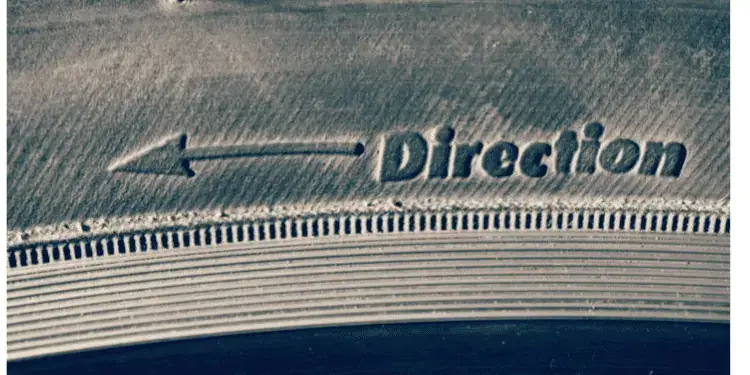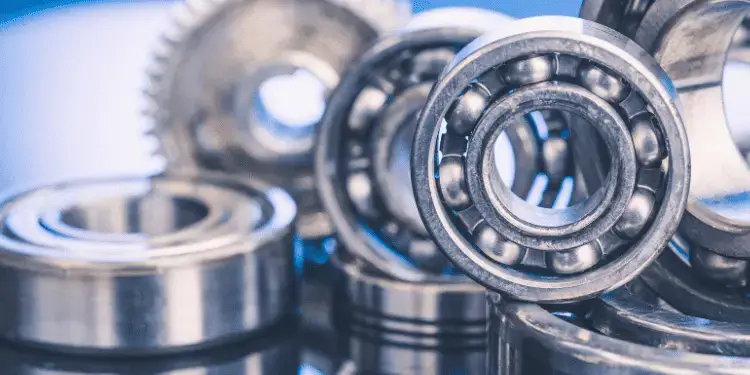It’s annoying. You do the right thing by rotating your wheels from back to front to prolong your tire’s life, but now you have noisy tires to put up with.
Here we’ll explore why you are experiencing tire noise after rotating them and what you can do about putting it right.
Before we get into the details, the two most common causes are:
- Directional Tires Have Been Crossed Over
- Cupped Tires or Worn Pattern
There are other less common causes which we’ll go into further on.
Let’s get into the details.
Directional Tires Crossed Over
A good tire shop will never make this mistake. Directional tires are designed to rotate one way; therefore, it’s fine to rotate them on the same side of your car. So front to back on the same side. Not left to right, though.
They have a tire pattern that works better in icy or wet conditions when rotating one specific way.

It’s easy to spot directional tires with an arrow pointing in the direction on its wall. If spun the wrong way, it creates excess tire noise as a result. It is often described as a humming noise.
Cupped Tires or Worn Pattern
It’s usually fine to crossover non-directional tires, but not always. All four wheels will wear the tires in a slightly different way. Sometimes some tires will wear more on the inner than the outer, and vice versa. Often you won’t tell the difference just by looking.
Get a tire gauge and take accurate measurements on the outside and inside tread wear. If there is a noticeable difference and you have crossed the tires over when rotating, you are now wearing down the raised surface of the tire.

Depending on how many mm one side is higher than the other dictates how long it will take to get to the same level as the lower side.
While the higher side wears, your car will be susceptible to more skidding and less grip. A large deviation in tread depth could require you to reverse the rotation.
Leading-edge pattern blocks wear differently on different wheels.
If other rotations have been front to rear, but this one is crossed, it could create noise.
Wheel Alignment Vs. Tire Balancing
Alignment Problem
Although tire rotation is recommended every 5000 – 7000 miles, depending on your car manufacturer’s guidelines, there is no such guide for wheel alignment. Wheel alignment problems usually show themselves in obvious tire wear on one side – especially if the camber and toe settings are misaligned.
Another tell-tale sign is the car veering off to the left or right. This may have been extremely slight before the tire rotation, but any force used to remove wheels from the assembly can misalign further.
If the alignment is good, the tires will adapt to the alignment after a few hundred miles. If in doubt whether the alignment is good, check the rear wheels balancing now after looking for uneven wear on them.
If you see none, then the alignment is probably good.
Related: Can Tires Be Put On Backwards – Yes and No
Tire Balancing
Tire balancing isn’t needed when rotating the tires, but if there is a noise, get your tires checked out.
A weight may have fallen off, causing one tire to vibrate, especially at higher speeds. This is rare, but if the weights are added to the wheel’s outward-facing side of the wheel check to see if there are any lighter/cleaner patches.
This could signify that a weight has fallen off recently. Most are stuck on with adhesive and do fall off, especially if the area they are stuck on wasn’t cleaned properly – with alcohol solution – beforehand.
Lugs Tightened
The most worrying error a tire shop can make is not mounting the lug nuts securely. The wheel will wobble if it is not thoroughly secured. This vibration makes the steering wheel. shake. It is, however, extremely unusual for this to occur.
Cross-threading the lug nuts is a possibility. Have you ever tightened a cap on a jar only to see that it’s not seated right after all? It’s the same process at work here.

Most car shops will remind you to check the lug nuts after 100 miles to ensure they haven’t worked themselves loose. In reality, few people do. Tire noise can indicate they are loose and need tightening. Check this out ASAP.
Wheel Bearings
Wheel bearings are tough. Thet spin around hundreds of times each mile you travel. Over time they wear as the grease leaks out and the metal bearings rub against each other and the race that encloses them. Wheels can be hard to remove.
Often the assembly is given a whack to help free it. If the bearings were close to failing, this could be the action that caused them to start grinding and rumble.

I know it’s not a tire noise, but people often talk about it similarly. Bearings don’t give a humming noise, so if that’s the noise you’re hearing, you can discount them.
Hub Caps Loose
Hub caps may not have been pushed back onto the wheel properly after a rotation. A nice easy check – if you don’t have rims.
They’ll make a rattling noise if loose, but at higher speeds, it is often described as a hum. Wire wheel covers are the worst if loose.
Will Tire Noise After Rotation Go Away?
If it is genuine tire noise and not alignment, balancing, wheel bearing, or any other possible cause mentioned above, it will go away by itself after a few hundred miles.
Related: Why New Tires Making A Roaring Noise
Conclusion
Irregular wear patterns before the tires were rotated are often the reason for loud tire noise post-rotation. If your tires were worn irregularly before you rotated them, your wheel alignment or tire balancing is probably out of sync.
As we have seen, there can be other reasons for the noise after rotation that aren’t tire-related.
It’s always best to ensure the lugs are tight, especially if the steering wheel is vibrating. That is the most dangerous cause of tire/wheel noise.
Make sure that directional tires are not crossed over (X over). Front-to-back on the same side is good. Side to side isn’t.
Bearings are another cause, but only if you’ve done the easier and more likely checks first. They usually show signs of failing before rotations if they are bad.
Alignment could cause tire noise, but unless you have other symptoms of alignment problems, tire noise is not going to be the only symptom. Car veering to one side and crocked steering wheel are more common signs.
Your tires may need balancing again. This is unusual as rotation doesn’t affect balance. A weight may have fallen off during the changeover, though.



![Can Tires Be Put On Backwards -[Answered Fully] directionl-tire-noise](https://carzaza.com/wp-content/uploads/2023/12/directionl-tire-noise-300x150.png)


![Car Wobbles At Low Speeds - [Troubleshooter Guide] inflating-tire-on-balancing-machine](https://carzaza.com/wp-content/uploads/2023/12/inflating-tire-on-balancing-machine-300x150.png)





